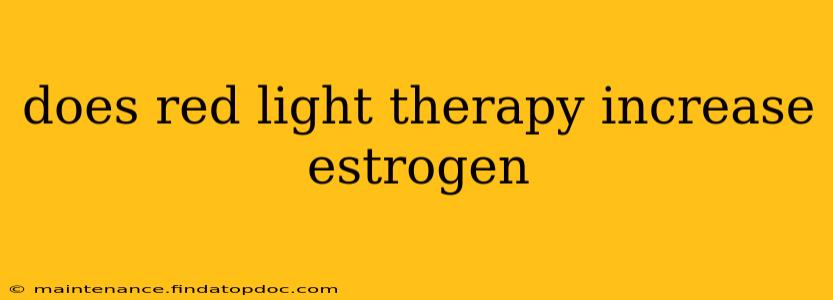The question of whether red light therapy (RLT) increases estrogen is a complex one, currently lacking definitive scientific consensus. While some studies suggest potential benefits related to hormonal balance, more research is needed to confirm a direct causal link between RLT and elevated estrogen levels. This article will explore the current understanding, addressing common questions and highlighting the importance of consulting healthcare professionals before using RLT for hormonal concerns.
What is Red Light Therapy (RLT)?
Red light therapy, also known as low-level laser therapy (LLLT), involves exposing the skin to specific wavelengths of red and near-infrared light. This light penetrates the skin's surface, potentially stimulating cellular activity and influencing various bodily processes. Proponents suggest it can benefit various conditions, including wound healing, pain management, and skin rejuvenation.
Can Red Light Therapy Improve Hormonal Balance?
While not directly increasing estrogen, some studies suggest RLT might indirectly influence hormonal balance. It's theorized that RLT's effects on cellular function might indirectly support the endocrine system's overall regulation, potentially leading to a more balanced hormonal profile. This is an area requiring further investigation. The observed benefits could be related to improved cellular function and reduced inflammation, which could positively impact various systems in the body, including the endocrine system.
Does Red Light Therapy Increase Estrogen Specifically?
This is where the current evidence is insufficient. There's limited robust scientific research directly linking RLT to increased estrogen production. Most studies exploring RLT and hormones focus on broader effects on hormonal balance or on specific hormone-related conditions, rather than isolating estrogen production as the primary outcome.
Can Red Light Therapy Help with Menopausal Symptoms?
Some women report experiencing relief from menopausal symptoms after using RLT. These symptoms often stem from hormonal imbalances, particularly declining estrogen levels. However, attributing such relief solely to estrogen elevation due to RLT is premature. The potential benefits may be related to RLT's effects on reducing inflammation, improving sleep quality, or boosting mood, which are all relevant to menopausal symptom management.
What are the Potential Side Effects of Red Light Therapy?
Generally, RLT is considered safe with few reported side effects. These can include mild skin redness or warmth at the treatment site, which typically subsides quickly. However, individual reactions can vary, and it's crucial to consult a healthcare provider, particularly if you have pre-existing medical conditions or are taking medication.
How Does Red Light Therapy Work in Relation to Cellular Processes?
The proposed mechanisms of action for RLT involve stimulating cellular processes through photobiomodulation. Light energy is absorbed by photoreceptors within cells, potentially triggering increased cellular energy production (ATP), improved circulation, and reduced inflammation. These effects could theoretically influence hormone production and regulation, but more research is needed to establish clear connections.
Is There Scientific Evidence to Support the Claims?
While anecdotal evidence and some smaller studies suggest potential benefits of RLT regarding hormonal balance, larger, well-designed clinical trials are necessary to confirm these findings and determine the extent of RLT's influence on estrogen levels specifically. The existing evidence does not provide conclusive proof that RLT directly increases estrogen.
Disclaimer: This information is for educational purposes only and should not be considered medical advice. Always consult with a qualified healthcare professional before using red light therapy or making any decisions related to your hormonal health. The effectiveness of RLT varies among individuals, and results may not be consistent.
